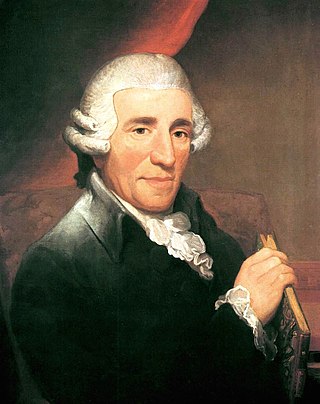
In music, a trio is any of the following:

Bellérophon is an opera with music by Jean-Baptiste Lully and a libretto by Thomas Corneille and Bernard le Bovier de Fontenelle first performed by the Opéra at the Théâtre du Palais-Royal in Paris on 31 January 1679.

La buona figliuola, or La Cecchina, is an opera buffa in three acts by Niccolò Piccinni. The libretto, by Carlo Goldoni, is based on Samuel Richardson's novel Pamela; or, Virtue Rewarded. This was Piccinni's most successful Italian opera. There was a sequel entitled La buona figliuola maritata (1761) by the same composer and librettist. La buona figliuola supposta vedova by Gaetano Latilla followed in 1766.

Medonte, re di Epiro is an opera seria in three acts by Giuseppe Sarti. The libretto was by Giovanni de Gamerra for Felice Alessandri's opera Medonte, re d'Epiro (1774) and was later set by several other composers.

Armida is a 1784 opera in three acts by Austrian composer Joseph Haydn, set to an Italian-language libretto taken from Antonio Tozzi's 1775 opera Rinaldo, as amended by Nunziato Porta, and ultimately based on the story of Armida and Rinaldo in Torquato Tasso's poem Gerusalemme liberata.

Calliroe is an opera by Antonio Sacchini, set to a libretto by Mattia Verazi. It was first performed in Schloss Ludwigsburg on 11 February 1770 and the ballets were set by French choreographer Louis Dauvigny.

Creso ('Croesus') is an opera seria in 3 acts with music by Antonio Sacchini, set to an Italian libretto by Gioacchino Pizzi after Book I of the Histories by Herodotos. The opera was first performed on 4 November 1765 at the Teatro San Carlo in Naples. The libretto was a popular one that had been first set by Niccolò Jommelli.

Giuseppe Francesco Bianchi was an Italian opera composer. Born in Cremona, Lombardy, he studied with Pasquale Cafaro and Niccolò Jommelli, and worked mainly in London, Paris and in all the major Italian operatic centers of Venice, Naples, Rome, Milan, Turin, Florence.

Zemira is an opera seria in three acts by Francesco Bianchi. The libretto was by Gaetano Sertor.

La villanella rapita is an opera giocosa in two acts by Francesco Bianchi. The libretto was by Giovanni Bertati.

Castore e Polluce is an opera seria by Francesco Bianchi. The libretto was one translated by Carlo Innocenzo Frugoni, from Pierre-Joseph Bernard's French text for Rameau's Castor et Pollux.

Arbace is an opera seria in three acts by Francesco Bianchi. The libretto was by Gaetano Sertor.

Seleuco, re di Siria is an opera seria in three acts by Francesco Bianchi. The libretto was by Mattia Botturini, after Antioco by Apostolo Zeno and Pietro Pariati, a libretto first set by Francesco Gasparini in 1705.

La morte di Cesare is an opera seria in three acts by Francesco Bianchi. The libretto was by Gaetano Sertor, after Shakespeare's play Julius Caesar.

Alonso e Cora is an opera seria in three acts by Francesco Bianchi. The libretto was by Giuseppe Foppa, after Ferdinando Moretti's Idalide, o sia La vergine del sole, as used by Giuseppe Sarti in Milan in 1783. The original source of this text was in turn Jean François Marmontel's Les Incas, ou La destruction de l'empire du Pérou (1777).

Le Marchand de Venise is a French opera in three acts by Reynaldo Hahn. The libretto was by Miguel Zamacoïs, after Shakespeare's The Merchant of Venice. Hahn first started working on the opera during the First World War, imagining it as a 'Mozartian' work, with the role of Portia written specifically with the soprano Mary Garden in mind.
Mattia Verazi was an Italian librettist primarily active at the court of Charles Theodore in Mannheim. He became known as the leader of a group of librettists who challenged the conventions of opera seria in the mid-18th century and was a long-time collaborator of composer Niccolò Jommelli. He also produced the libretti for Salieri's Europa riconosciuta, Sacchini's Calliroe, and J. C. Bach's Temistocle
Marianna Bianchi Tozzi was an Italian soprano best known for creating the role of Eurydice in Christoph Willibald Gluck's opera Orfeo ed Euridice (1762).








